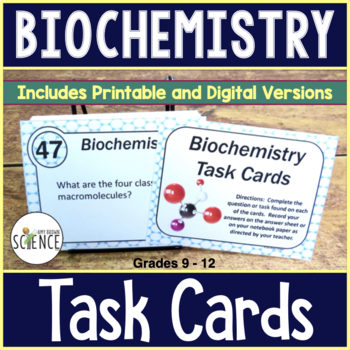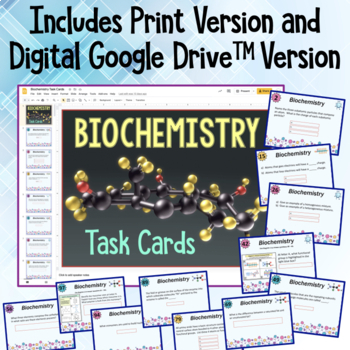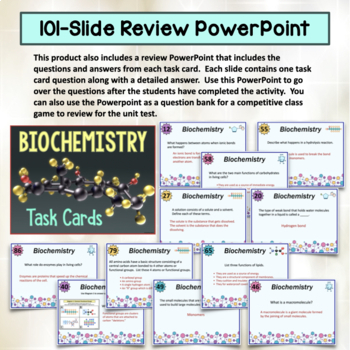Biochemistry Macromolecules Organic Compounds Task Cards
- Zip
- Google Apps™

What educators are saying
Description
This set of 101 enrichment, reinforcement, and review task cards for your lessons on Biochemistry will ensure that your students have mastered the concepts. Both printable and digital versions are included. Questions cover matter, chemical bonds, the properties of water, carbon compounds, carbohydrates, lipids, proteins, and nucleic acids. See detailed list of topics and concepts below.
Both printable and digital versions of this resource are included. The student handouts and task cards can be printed or used in the paperless digital format in your Google Drive, Google Classroom, Microsoft OneDrive, or similar. This resource is perfect for traditional classroom settings, 1:1 schools, or for distance learning.
What is included in this resource?
- A set of 101 FULL COLOR, printable, and editable task cards.
- A set of 101 LOW INK, printable, and editable task cards.
- 2 printable Full Color diagrams used to complete select task cards.
- Paperless digital version for use in Google Drive, Google Classroom, and/or Microsoft OneDrive.
- A student answer sheet for recording answers.
- Blank task cards so that you can add additional questions.
- Teacher Guide containing tips, directions, and suggestions.
- A complete teacher answer key.
- A teacher answer key PowerPoint that can be used to go over answers with the students.
=========================================================================================
These task cards were written to supplement my Biochemistry PowerPoint and Notes Set.
Click this green text to view this teaching PowerPoint.
=========================================================================================
Task cards are a fantastic way to enrich or reinforce lessons, review difficult concepts, or provide extra practice for the struggling student. The student reads each card, performs the task, and records his/her answer on the included student answer sheet.
From the moment of purchase, you will be ready to use your task cards in just a few minutes. Simply print the sheets of task cards on card stock paper, laminate, and cut the cards apart. The cards look best when printed in color, but they can easily be printed in black and white.
This set of 101 task cards on Biochemistry covers the following concepts and topics:
- The Nature of Matter: Atoms, subatomic particles, mass and charges of the subatomic particles.
- Elements: Definitions, isotopes, the nature of compounds.
- Chemical Bonds: Definitions and examples of ionic and covalent bonds, polar molecules, polar covalent bonds, nonpolar covalent bonds.
- Properties of Water: The polarity of water molecules, hydrogen bonding, cohesion and adhesion.
- Mixtures: Definition, homogeneous and heterogenous solutions, solute, solvent.
- Reasons why water makes life possible.
- Acids, Bases, and pH: The pH scale, definitions of acids and bases, buffers, why buffers are essential to the life of a cell.
- Carbon Compounds: The difference between organic and inorganic compounds, the characteristics of carbon that allow for the building of a large variety of biological molecules.
- Functional Groups: Definition of functional group and their role in chemical reactions. Four common functional groups are covered: Hydroxyl, carboxyl, amino, and phosphate groups.
- Macromolecules; Definition of macromolecule, groups of macromolecules, polymerization, monomers, polymers, condensation reactions, hydrolysis reactions
- Carbohydrates: Examples of carbohydrates, characteristics of carbohydrates, building blocks or monomers of carbohydrates, functions of carbohydrates in cells, monosaccharides, disaccharides, polysaccharides, starch, glycogen, cellulose.
- Lipids: Examples of lipids, characteristics of lipids, building blocks or monomers of lipids, nonpolar nature of lipids, fatty acids, glycerol, saturated and unsaturated fats, triglycerides, phospholipids, waxes.
- Proteins: Examples of proteins, characteristics of proteins, building blocks or monomers of proteins, the structure of amino acids, dipeptides, polypeptides, the relationship between shape and function of proteins.
- Enzymes: Definitions and the role of enzymes in cells, substrate molecules, active site, products.
- Nucleic Acids: Brief introduction to nucleic acids, two type of nucleic acids, building blocks of nucleic acids.
Related Products Include:
Biochemistry PowerPoint and Notes Set
Biochemistry Google Sheets Hidden Picture Reveal Activities - 4 Game Set
Lab: Testing for Organic Compounds in Foods
Macromolecules Color by Number Activity
Biology Buzz Words: Biochemistry and The Chemistry of Life
LAB - Catalase: An Enzyme Common to Both Plants and Animals
Organic Compounds Homework or Quiz
Organic Compounds Mix/Match Game
Lab: The Release of Heat in an Enzymatic Reaction
Biochemistry Homework Assignment and Study Guide Worksheets
Organic Compounds Graphic Organizer
Biochemistry Jeopardy Review Games - Set of 2
Test: The Chemistry of Life (Biochemistry)
The Properties of Water PowerPoint and Notes Set
For updates about sales and new products, please follow my store:





